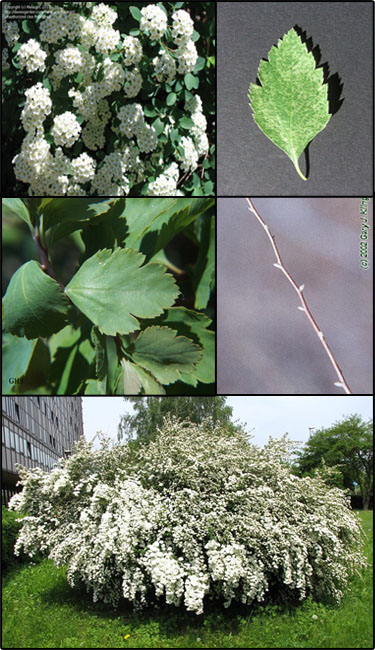Vanhoutte spirea (Spiraea xvanhouttei)
 Description: Used as farmstead windbreaks, highway beautification, medicinal properties.
Description: Used as farmstead windbreaks, highway beautification, medicinal properties.Habit: Medium deciduous shrub, vase shaped, 6-8 ft tall with a spread of 12 ft, fiberous/spreading root system, Hybrid cross between Spiraea cantoniensis and Spiraea trilobata.
Leaves: Simple, ovate to rhombic-ovate, apex pointed, base wedge-shaped, teeth irregular, coarse, often incised or obscurely 3-5 lobed, dark, smooth pale glaucous below, 3/4-1 3/4 in long and 1/2-1 1/4 in wide, dark, dull blue green on top; silvery-gray below, purple fall color.
Stems: Spreading; arching branches; thin; brown in color; glabrous; branches at 90 degree angles.
Flowers: Numerous flowers, form on branch tips; 1-2 in diameter, very showy, umbel-like, white in color; blooms April through May.
Fruit and seeds: Dry, small follicles, brown in color.
Habitat: Prefers well-drained soil, full sun to light shade, soil tolerant.
Reproduction: By seed or softwood cuttings.
Similar species: Threelobe Spirea (Spiraea trilobata), a denser, compact parent of Vanhoutte Spirea.
Credits: The information provided in this factsheet was gathered from North Dakota State University and the UConn Horticulture Plant Database.
Individual species images that appear with a number in a black box are courtesy of the Bugwood.org network (http://www.invasive.org).Individual photo author credits may not be included due to the small display size of the images and subsequent difficulty of reading the provided text. All other images appear courtesy of Google (http://images.google.com).
